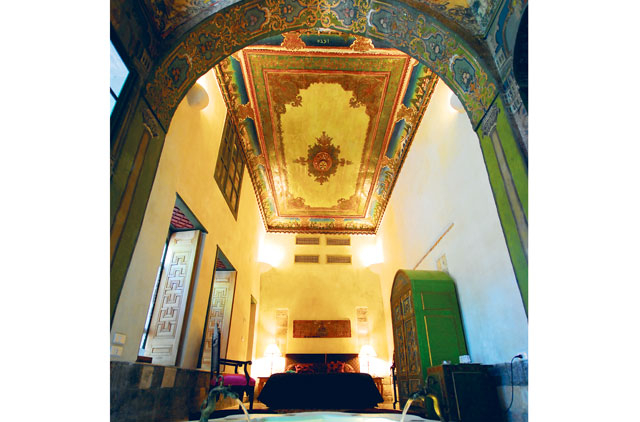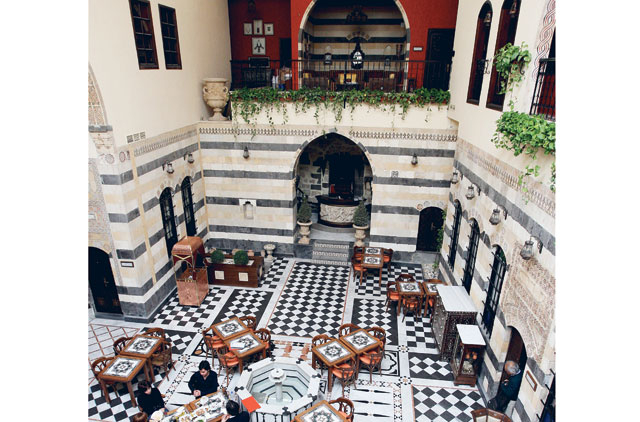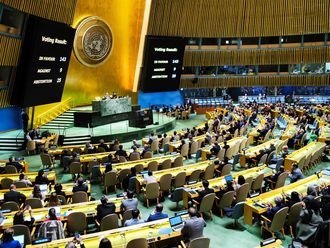
When in Syria, live like a Syrian.
This is the catchy slogan devised by the creators of a website dedicated to Syrian Boutique Hotels (www.syriaboutiquehotels.com). SBH, launched just over a year ago, is a direct response to the snowballing boutique hotel scene in Old Damascus, which is attracting tourists from Europe, the United States and the Far East.
SBH is the only fully automated online reservation system directly linked to all boutique hotels in Syria. In addition to reservations, it offers the "You have a Friend in Syria" concierge service for tourists, where they receive a phone number they can call when in Syria for any assistance round-the-clock in Arabic, English and French.
Speaking to Weekend Review about the rise in boutique hotels, the creator of the SBH website, Marwan Arcouche, a co-founder of L'Hotelier Management and Advisory, said: "SBH is an initiative that aims to promote the old cities and boutique hotels in Syria.
"The uniqueness of the offering of our exclusive boutique hotels is the experience of living like a Syrian. It is quite interesting to see corporate guests staying in the Old City to enjoy this experience that cannot be lived elsewhere."
"Tourism is one of the most promising sectors in Syria. It has been attracting more investments. And even foreign investments are starting to get directed towards boutique hotels as demand is quite high compared to supply," he added.
Tourism is booming in Syria and according to the World Travel and Tourism Council, the contribution of travel and tourism to the country's GDP will rise from 11.2 per cent ($4.67 billion) in 2009 to 13 per cent ($7.7 billion) by 2019. Tourist figures for 2009 showed 6.09 million visitors, 3.59 million of whom were from the Arabian region. Another 1.4 million were non-Arab or foreigners, while 1.06 million were Syrian expatriates. Total nights spent in hotels were 936,845 by the end of 2009, a 17 per cent increase from 2008.
Noticeable increases were noted among Dutch tourists (31 per cent), followed by British (26 per cent), while Italians and French (25 per cent) and Swedes increased 24 per cent. The Saudis were up in 2009 — thanks to a cooling of political relations — by 18 per cent while Bahrainis, Kuwaitis and Emiratis increased 15 per cent over 2008.
Twenty years ago, tourists coming to Syria usually visited the Castle of Saladin, the ancient city of Palmyra and particular monuments in Damascus such as the Azm Palace, the Umayyad Mosque and the Church of Mary. Apart from these attractions, topped with tea and shisha at the old Nofara café behind the Umayyad, old Damascus — the oldest inhabited city in the world still standing — was more or less neglected territory, thanks to the modern and trendy neighbourhoods that were mushrooming throughout extensions of the Syrian capital.
The cost of maintaining homes in the Old City was too high to bear and it became increasingly inconvenient to live in a narrow cobbled street where, among other things, parking was impossible. In the past, entire families, up to 20 per household, used to make sure that these homes and their gardens were well preserved year-round.
As joint families shrunk in size, many began to frown upon the idea of living in such mansions — letting them decay with the passing of time.
The mansion of Syria's first president, Mohammad Ali Al Abed (1932-1936), in the historic Suq Saruja area, for example, is an abandoned masterpiece in which parts of its quarter have been transformed into a shoe-manufacturing workshop.
In the same locality lies the residence of Abdul Rahman Al Yousuf, who led the pilgrims annually from Damascus to Makkah, sprawled over a massive 2,500 metres, which has also been abandoned and is now rented in small rooms to labour workers cramped into crowded living departments.
In 1994, investors decided to transform these homes into boutique hotels — enabling tourists to spend their nights within the high walls of the Old City, "to live like the Syrians lived" for 5,000 years in mosaic-decorated rooms with spacious courtyards and lemon trees surrounding the water fountains.
The harmonic azan of the Grand Mosque of the Umayyads could now be heard first-hand and everything one needed to see — from tourist attractions to the old spice bazaars of Bzuriyah and Hamidiyah — was within walking distance of these new boutique hotels. Gone seemingly were the days of the old and ageing, yet large hotels, such as Sheraton and Meridien, which had catered to tourists in Damascus since the 1970s.
Investor appetite in the Old City was the result of a chain effect that started with Aleppo in northern Syria in the early 1990s, reaching Damascus in 1994. Back then the term "boutique hotel" (which came into use in the US and London in the 1980s) was still unheard of in Syria.
It slowly invaded the Syrian dictionary as a small, cosy, intimate and luxurious hotel with a theme, very different from the massive Four Seasons, for example, which opened its doors in Damascus in late 2005.
Present homes were in dire condition and needed to be renovated — either by their inhabitants or by investors. Renovating these homes back then into cafés and restaurants was not an easy task. It was done with great care, under supervision of the Municipality of Damascus, to make sure that the Arabian identity of these residential mansions, which has survived thousands of years, was not distorted.
Centuries of visitors, ranging from early Arab geographers, European merchants and colonialists in the 20th century, were among those who were enchanted by the magic of Damascus. There was no reason why modern tourists could not live the same indulgence — with the comforts of modernity, air-conditioning, wireless internet in bedrooms and conference rooms.
Restaurants in the Old City — a success story that fuelled the boutique hotel trend — now exceed 100, while the number of licensed hotels stands at 31, 14 of which are already operational. A night at any of these hotels costs $250 to $300.
Beit Zaman is a 300-year-old home located in a Roman-era street and is among the first boutique hotels in the Old City. Another is the Old Vine Hotel, a 17th-century nine-bedroom hotel minutes away from the Umayyad Mosque.
Other major tourist attractions in recent years include Beit Rumman, in the Bab Touma district, Beir Al Mamlouka, a 17th-century eight-bedroom hotel, and Talisman, a 1,600-metre luxury hotel in the Jewish quarter of the Old City.
Beit Rumman was originally purchased to turn it into an artistic salon but is now a luxury hotel with elements from the Islamic, Mameluke and Ottoman eras, accompanied by verses from the holy scriptures, both the Quran and the Bible.
Talisman — the first to emerge in the Old City — now has Talisman II in the Bab Al Salam neighbourhood and plans to expand in three other Syrian cities. In 2007 it was visited by the speaker of the US House of Representatives, Nancy Pelosi.
Al Pasha Hotel, another novelty, adjourns three old 18th-century Damascene mansions, with rooms named after pashas from Syrian history: Sultan Al Atrash (commander of the 1925 Syrian revolt against the French), Ahmad Izzat Al Abed (senior adviser to the Ottoman Sultan Abdul Hamed II), and Ottoman governors Midhat Pasha, the great reformer, and Asaad Al Azam.
The largest of these hotels cannot accommodate more than 28 rooms, explaining why a return on investment might not be as fast as investors would like. In the Bollad Alley of Bab Touma, yet another boutique hotel stands on 800 metres and dates back to 1836. It has 12 rooms, each of which cost not less than 7 million Syrian pounds to renovate.
Mustafa Ali, the world famous Syrian sculptor whose classy atelier is two houses down from the Talisman, notes that his "cost 8 million pounds to buy, and then I spent another 20 million pounds to renovate." Projects such as these, which have mushroomed all around the boutique hotels, have sent prices of real estate and renovation through the roof in the Old City.
The boutique hotel trend that has electrified the Old City has not passed, however, without criticism. Amal Mahasin, the secretary-general of the Friends of Damascus Society, claims that these projects have no tourism objective and are being erected for commercial gain only. She claims that preserving the identity of these homes is a must, and so is properly compensating residents of the Syrian capital.
"We demand" she noted, "that support is given to residents of the Old City, through necessary loans to renovate their homes, in coordination with authorities, to be assured about the future of these homes." She asks: "What if Old Damascus was transformed in full into hotels and restaurants? Where do the original residents go?"
Some local residents are also not eager to see the Old City being transformed into a hub for clubs, restaurants and hotels.
"It clutters the sewage system," said Iyad of Al Manakhliya, behind the Citadel of Damascus, "and the streets become noisy, busy with strangers. You see people drunk on the streets at midnight. This is haram — not part of our culture or society!"
Sami Moubayed is editor-in-chief of Forward Magazine in Syria.














